Please Go Away… We’re Reading
A Practice Approach to a Taken-for-Granted Academic Craft
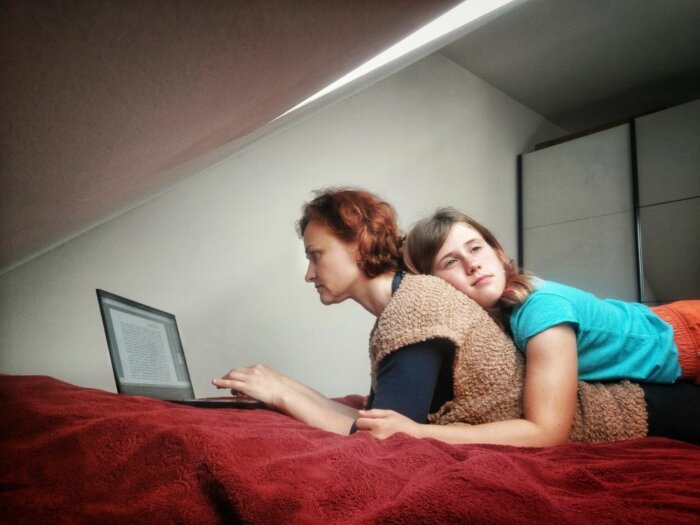
1_Introduction
The Danish verb for reading, læse, also means studying: I study anthropology = jeg læser antropologi. Similar is the Finnish “luen,” as in luen antropologiaa. On the other hand, the Finnish noun for a lecture, luento, is “a situation of reading.” The German noun for a lecture, Vorlesung is literally an “event of reading in front of someone,” a meaning we shall return to.
Different languages engage with reading in different ways. Some indicate the intimate relationship between reading and study(ing), between reading and knowledge practices. Nonetheless, reading practices and the modes of reading in academia are rarely thematized within academic discourse. The practice of reading is rarely an object of epistemic exchanges in seminars, at conferences, and among colleagues. It is as if reading were such a matter of course for the professional reader, that it is not worth academic attention, much like going to the bathroom or sleeping. In the following, we present a range of perspectives on this aspect of professional reading.
In “Good Readers and Good Writers,” the novelist Vladimir Nabokov claims that the text is not a finished object but is designed to be completed through reading; there is only rereading and rethinking in the process of reading. [1] Such reasoning is not alien to Science and Technology Studies (STS); as a field, STS is interested in scientific knowledge production, focusing crucially on the technical apparatus and social practices involved in the production of science. In their classic, Laboratory Life: The Social Construction of Scientific Facts, Bruno Latour and Steve Woolgar characterize laboratory practice as text production saturated with description devices. [2] The premise is that these productions are eventually read one way or another.
Furthermore, reading as a diverse practice has been mythologized and its multiplicity thereby reduced. [3] For example, although Friedrich Nietzsche documented his cursory ways of reading, [4] this practice was systematically ousted from the history of Nietzsche’s reception. [5] It might be more appropriate to think of an ‘ecology of reading,’ [6] where different ways of reading cohabit. In other words, there might be a specific myth of reading, [7] but not only one mode of reading practice.
In this paper, we investigate reading as an academic practice based on auto-ethnographic exchanges among ourselves. We, the authors of this _Perspective, are all academics and therefore experts in academic reading. Some of us are students, others PhD scholars, post docs, and professors. We inquire how different modes of reading in academia unfold and how they are organized through temporalities, places, bodies, and tools. For the sake of focus, we address only reading of academic research publications such as reference books/monographs and papers; although interesting and without doubt constituting a major part of what we read, we bracket out emails, newsletters, student papers, websites, social media, datasets, source code, field notes, archive documents, faculty meeting memos, etc.
Our text centers on three modes of reading, situating this common academic activity into different reading places and infrastructures as we read about, around, and aloud. We offer several vignettes that present reading experiences. Some of them are accounts given by individual persons, while others are analytical constructions out of the experiences of several of us. We conclude by inviting readers to ponder whether the development of reading capacities, skills, places, times, materialities, bodies, and attitudes is part of their professional development and one that their working environment nurtures.
2_Three Modes of Academic Reading
We understand a mode of academic reading as a specific way of engaging with academic texts. In what follows we name three: reading about, reading around, and reading aloud.
2.1_Reading About
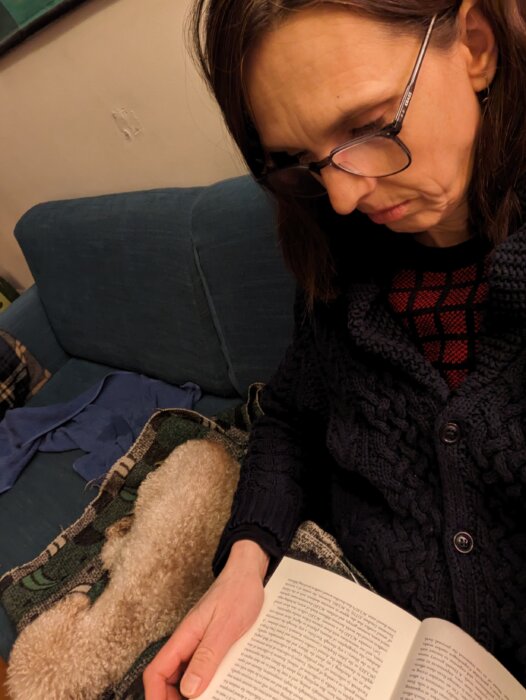
There is so much to read. Too much, I’ll never catch up. I’m always behind. Academic reading is saturated with the fear of missing out. It is about being efficient. I read like a detective to find exactly the quote I can use, exactly the argument that works for the text I am writing.
“Reading about” is an instrumental mode of academic reading. It resonates with the everyday work of writers, teachers, reviewers, editors, researchers, and students. Having a specific goal, a particular question, turns the reading into a rational process of purpose, of searching for answers, and of selecting topic-relevant quotes. Efficiency is key. “Reading about” is mostly writing-reading; not for the sake of reading itself but for the sake of doing something else, most often writing. In the “reading-about” mode, we read to find, underline, and copy-paste arguments, search for examples and insights we can use for our own writing. Reading is in service of writing. STS scholar Paul N. Edwards emphasizes the importance of this mode for scholars, giving instructions on how to read more efficiently and effectively. [8] For all our academic reading experts, instrumental reading takes up most of our reading time.
One of our experts is often hesitant to discuss her recent readings, as they are so specific to her own research projects that they seem irrelevant to others. Sharing is not the point of this mode of reading. Instrumental reading is individual. One has to think other things and people away and isolate oneself from others’ curiosity or engagement.
Many academics collect… nay, hoard books and articles to explore later: PDF files from various sources downloaded on the computer or in cloud storages, waiting to be read. Shelves of books in the library, home, or office waiting to be discovered. Their waiting is not inconsequential. While massively filling up shelves, hard drives, and data centers, they create pressure on academic humans to read them. As academic readers, we struggle to develop routines to organize our exploration, categorization, and classification of texts to help us decide what to read superficially and what to read in detail. Whole professions of information and library studies have been developed to infrastructure academic reading. One of us experiences that reading in detail becomes easier after tidying up their desk and even the room where they organize the environment for a detailed reading practice.
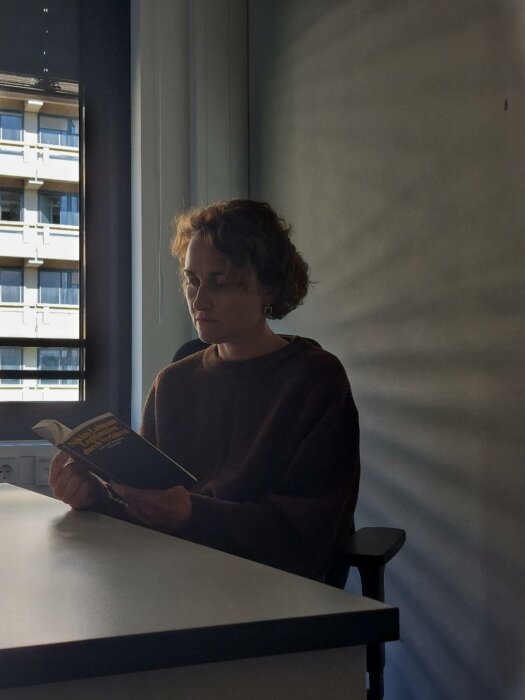
Edwards emphasizes that you should reserve specific time slots to read. [9] In practice, this is difficult to realize. Some of us have small children and we all have other relational obligations at our institutes, faculties, departments, and labs that continuously require our attention. They make it difficult to reserve specific time slots for reading. We have to read whenever there is a minute. We read on trains, on buses, and in crowds. Particularly when the internet connection is poor.
Yet it does happen that we find extended time. These are the good moments when we can relax and concentrate on just this one activity: reading. Comfortable armchairs, beds, and couches are crucial material infrastructures for the mode of reading about. All our reading experts have places in which we usually find ourselves reading. The body has to be able to relax. We read better on the couch than at the desk.
I had to study for a major exam. I spent two years in the library. You could not take out many books, so I had to sit there and read. It changed my reading habits, and it also changed my writing style; it became more formal. It is difficult to write in an informal and engaging way when you feel you are just a conveyor belt of words from the reading to writing.
Students in our part of the world and scholars in less wealthy regions have to read in the reference library because they cannot take out books. They are forced to sit in a public room; they do not have the liberty to choose a reading spot that fits their bodies. They need to discipline their bodies to fit the offered reading spaces.
Max Liboiron critiques what we call the “reading-about” mode. [10] They identify this mode as extractivist and consumerist, because readers do not engage in exchange with the author but seek to take away as much as possible for themselves, ignoring the rest. This resonates with one of our reading experts, who feels she has been so drilled in this instrumental mode of reading about, that she tends to focus only on single utterances and text bits and often forgets the overall argument of a text.
However, one of our reading experts noted that reading about also sometimes involves exchange, and indeed ‘Easter eggs’:
Sometimes, I am lucky to get a second-hand book or a library book in which someone has underlined, marked up, and made comments. Then reading also becomes a conversation with former readers. Some readers are emotional and speak directly to the authors. They write “sic!” or “REALLY???” or “yes!!” in the margins. Others are bureaucrats and separate the text into smaller units, draw meticulous lines, and add their own headlines to the sections. I’m thankful to those readers who add thoughts and references: “post-structuralist critique” or “cf. Haraway,” or “see p. 239.”
The reading-about mode does not only engage in extracting excerpts. It is also about constituting a personal academic memory of texts and arguments. In a short text on how researchers and students can learn to read, sociologist Niklas Luhmann assumes that some kind of long-term memory is essential for reading—especially of academic texts. [11] Famous for building the elaborate Zettelkasten note-taking system for himself, Luhmann (surely) refers not only to individual and mental ways of memorizing but also to material techniques of building and expanding such a long-term memory. Our reading experts developed routines for managing the reading-about mode’s conflict between extractive reading and reading for memory. To limit the extractive mode, one of our experts of academic reading forced herself to read without a pen—at least without having it in her hand. This makes the bodily effort of extracting single bits from the text by underlining and taking notes more strenuous, so she refrains from it. Not holding a pen while reading makes her read longer passages—or the whole text—without taking notes. It makes her attend more to the overall argument, ignoring details. Another of our reading experts developed the routine of listening to texts read aloud by a text-to-speech application, which also had the effect of foregrounding the general point of texts, rather than the details.
To sum up, key to the reading-about mode of academic reading is its goal-oriented, instrumental, and opportunist nature. It unfolds in all kinds of places, but preferably in places that allow readers to isolate themselves from disturbance. Time management is crucial for this mode of reading: moments when children are asleep or when the internet in the train is down are exploited for academic reading about. Armchairs and couches are important material objects for this mode of reading. They help the body relax and the mind focus. Pens are necessary for extractive reading, as are memo-techniques such as note-taking. While the instrumental and individual character of reading about is central, engagements with the overall argument, exchanges with authors’ ideas and with other readers’ notes also unfold in this mode.
2.2_Reading Around
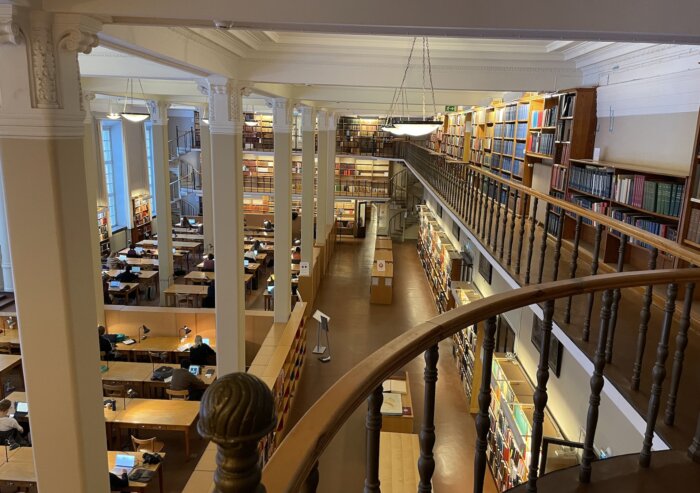
Picking up a book. Opening a random page. Reading a few sentences. Browsing to another random page. Reading a few sentences. Browsing back. Reading. Browsing ahead. Reading. Browsing. Reading.
An inquiry into the smallest particles of the practice of reading can be found in Eric Livingston’s An Anthropology of Reading. [12] In an ethnomethodological way, he studies poetry by asking how readers move from one word to the next, one sentence to the next, one paragraph to the next. While this linear way of reading may correspond to an author’s idea of the text, and indeed to many reading practices, the reading-around mode of academic reading follows a different, less authoritative path. “Reading around” disregards the linear sequence of texts laid out by the author and takes a stroll through texts. The mode seeks no order and no single or holistic argument. The non-committal flâneur frees themselves from the common ground for mutual process, reads individually, and leaves fewer possibilities for collective engagement.
“Reading around” is a mode of reading that can be practiced with any text. However, there are places, textual forms, and things that are particularly suited for this reading mode. While reading in offices is most often in the mode of reading about, reading around unfolds in book shops, cafés, and waiting rooms, but also in libraries or perhaps in a colleague’s office and certainly online. Sitting in a café, waiting for an appointment and being in places where temporary presence does not provide time to read whole books, but allows for reading around, browsing through texts or snippets, and moving on to the next. Different genres mix. Reading around is also common at bookshops, which allows one to form a first impression of a book, get seduced by it, and which helps to decide if a longer commitment is desirable. Yet reading around is also done to books of others, colleagues, friends, or hosts as well as books that catch our eye, but in order to evaluate our interest in them further, we must explore them. One of our reading experts warned us that in some cultures picking a book off the shelf at a colleague’s office to read around is very rude.
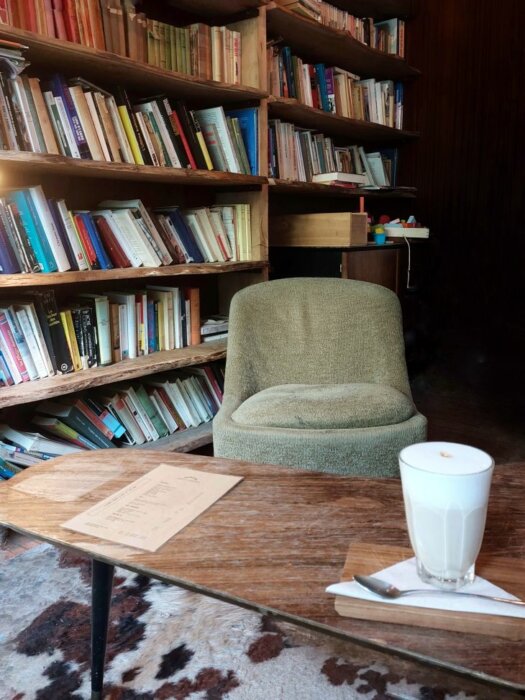
While place and text form are of importance for reading around, so are textures. One of our reading experts is particularly fond of books and paper that feel good to the touch. Fabric covers, imprints, or embossing that creates reliefs invite touching and sometimes even enable feeling the letters and words printed on paper. [13] The paper itself, its thickness, smoothness, and general feel is just as important. Reading around is aesthetic, sensuous. It is not limited to intellectual pursuits, but an open-ended mode of the readiness to engage with and be affected by different material or immaterial discoveries. This mode of reading is about making the process itself a pleasurable experience. It embraces unexpected findings and emotional affordances. The materialities of books and paper shape the practices of reading them. Reading around inspired the semiotic-material forms of entire genres and media: short text pieces, headings, or images that draw attention and evoke further reading, layout design, as well as high quality photos to be admired more than read. This mode values inspiration over information. Such styles and genres are the very infrastructure of this reading mode, however rarely appreciated in academia. Neither is the mode of reading around. It is an informal mode of reading at the margins of the instrumental reading mode.
This mode of reading can also involve browsing and re-reading academic texts. Books read a long time ago, arguments we are unable to recall fully, or all-time favorites are often re-read in a reading-around mode. Opening a book at random, to read an eye-catching paragraph and appreciate the way it is put is a way to re-discover ideas, get inspired, and spark thought.
In the reading-around mode, time, space, materiality, and bodies are intimately linked: stolen moments in whatever space that holds texts—mostly books—are apt for reading around. The materiality and aesthetics of texts give the body tactile and voyeuristic pleasure: fingertips browsing, lips smiling, no pre-given order.
2.3_Reading Aloud
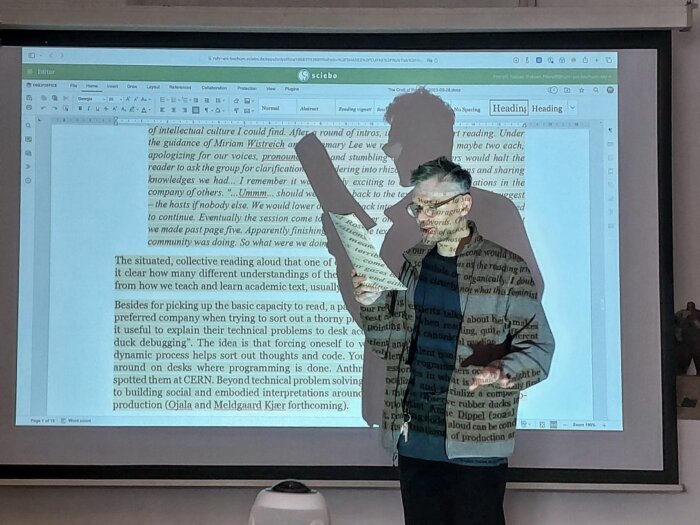
Reading aloud could be considered the origin of academic reading. The concept of a lecture, a Vorlesung in German (literally “an event of reading in front of someone”) points to early scholastic, educational, and instructional practices which have shaped contemporary academic culture. This essay started by looking at the word for “reading” in a selection of languages we speak. Also in English, the Latin originating “lecture” means reading, not speaking. It is a reminder that scholarly reading was originally a vocal and social event. Only one person had access to the text, while the audience would be listening, perhaps scribbling notes for later study. Opposed to pre-printing reading cultures, in today’s academic cultures everyone usually has access to a printed or digital copy of a text. One of the radical aspects of the Protestant Reformation from the 16th century onwards was publishing the Bible in native languages, departing from the prior only Latin Bibles. In some cultures, it challenged the authority of one person reading aloud.
Even in a plurivocal and pluritextual time of social media, the lecture remains an enduring core mode of academic communication. There are forms of reading aloud in academia that are accepted, even institutionalized, and enforced. The quintessential one is to read one’s own pre-composed texts out at lectures and conferences. It seems more accepted than reading others’ texts aloud. However, to read out one’s own text instead of talking freely is sometimes regarded as bad (academic) frowned upon in academia. An alternative, reparative response would be to sympathize with the perhaps inexperienced, neophyte, nervous, or sleep-deprived presenter who is leaning on a crutch to perform well under the real social pressures and banal time limits within which contemporary academic life is routinely organized.
One of our reading experts feels reading aloud to be loaded with shame; students are frequently embarrassed by being made to read texts aloud in class. As if reading aloud were an implicit accusation—as if they did not have the capacity to read and understand the text on their own. As if reading aloud were only for children?
While reading aloud in academia might be considered less efficient, it opens up room for negotiations of the text, a form of close reading that makes implicit (dis)agreements tangible. Consider this:
“What a tiny place,” was my first thought as I stepped into the pale, furnitureless front room of a small gallery space straight from the street. Half a dozen people were already seated on modest pillows on the floor, and a few more were stepping in from the famously miserable, dark, wet Copenhagen winter weather. This was the reading group I had somehow heard about via Facebook which was still in vogue at that time… as a newcomer in the city I devoured all nuggets of intellectual culture I could find. After a round of intros, it was time to start reading. Under the guidance of Miriam Wistreich and Rosemary Lee we read a paragraph, maybe two each, apologizing for our voices, pronunciations, and stumbling on words. Others would halt the reader to ask the group for clarifications, meandering into rhizomes of associations and sharing knowledges we had… I remember it was terribly exciting to draw those associations in the company of others. “…Ummm… should we … come back to the text…?” someone would suggest—the hosts if nobody else. We would lower our gazes back into our printouts as the reading tried to continue. Eventually the session would come to an end either on schedule or organically. I doubt we made past page five. Apparently, finishing reading the text was clearly not what this feminist community was doing. So what were we doing?
The situated, collective reading aloud that one of our reading experts talks about here makes it clear that many different understandings of the text emerge when reading, quite different from how we teach and learn to read academic texts, usually pointing to a canonical interpretation.
Reading aloud as a collective reading mode is a form of engaging with text beyond individual practice. It helps to formulate, discuss, and relate ideas. A similar approach is applied by programmers in what is known as “rubber duck debugging;” explaining thorny problems to the silent non-human ear of a rubber duck. The idea is that forcing oneself to vocalize and serialize a complex and dynamic process helps sort out thoughts and code. You might observe rubber ducks lying around on desks where programming is done. Anthropologist Anne Dippel spotted them even at CERN. [14] Beyond technical problem solving, reading source code aloud can be conducive to building social and embodied interpretations around its situations of production and co-production. [15]
What are the spaces, the time, the materialities, and the bodies of the reading-aloud mode of academic reading? The spaces are collective, the time is organized and agreed upon in advance. Key materialities are the texts themselves, but also the bodies listening, turning writing into sound that at one and the same time enters all bodies present, uniting them in this collective corporeal moment. [16]
3_The Status of Reading in Academia
In our conversation as reading experts, we noted that reading is a worse excuse for not showing up at a department meeting than writing is. You may get away with skipping a meeting if you are working to submit a manuscript or a funding application, but not if you are reading. We all would feel uncomfortable ignoring administrative or teaching obligations to prioritize reading an exciting article—or even worse, a book. Imagine the Dean knocks on your door and you answer: ‘Go away, I am reading’—a breach of social order! Academic reading does not only come in different modes, shaped by different constellations of places, times, bodies, and materialities. Reading also has certain value in academia. In this final section, we look into the status of reading in academia.
I love to read different kinds of literature: Kittler, Krämer, Kant, novels, psychological advice. Reading is like an ornament of education that I adorn myself with. I read to decorate myself. It makes me beautiful. Reading is a transformative process, it is freedom, aesthetics. It kills everything when someone asks me: What did you get out of it?
This quote from one of our reading experts expresses a clash of the value of relating to texts as a personal engagement and the value of accounting for what texts communicate. Reading for pleasure and adornment has a low status in academia, while reading for production is key. Curiously, the latter depends on ignoring the former.
While not discussing specifically academic reading, we find novelist Rainald Goetz’s thoughts helpful for analyzing the status of reading in academia. In his piece on “absolute idealism” Goetz proposes that reading is connected to freedom of thought, while writing comes with a “vice-like” obligation to order and administrate. [17] The association of reading with freedom of thought resonates with the reading-around mode, and the obligation to order has similarities to the reading-about mode, which has direct links to writing. While freedom of thought surely has a high value in academia, it is—like reading—not what researchers put on their CVs (why not add a reading list next to the publication list?). What is written and published will add to the status of the researcher, not what they have read.
The differentiation between reading and writing is helpful to point out their different status. The experiences of our reading experts on the previous pages, however, show that, in the thicket of reading practices, passages and transitions between these ideal types of writing and reading are shaped. Marking utensils are the key devices for creating the passages between reading and writing and hence between reading’s “mere” freedom of thought or ornamentation and writing’s obligation to order, which can later be accounted for. For all our reading experts, a key part of academic reading is the pen, and not only for fidgeting. Some of us use a ruler to ensure underlining is nice and straight. Others use different kinds of lines—straight lines for important utterances, waved lines for areas of disagreements. Lines are not only drawn under sentences, but also in the margins: single lines, double lines, waves, arrows, and exclamation marks to indicate importance. Many of our reading experts always have annotation tools ready when reading; one never knows when this need may arise. One could stick to the dichotomy of reading and writing and treat ruler and pencil as material tokens for switching from one to the other. Pencil and ruler open up the possibility to stop reading and collecting words and phrases that seem worth holding on to. Softly and preliminarily highlighting text while reading can be an integral part of the ‘exuberance of joy’ of having found something interesting that Goetz attributes to reading. [18]
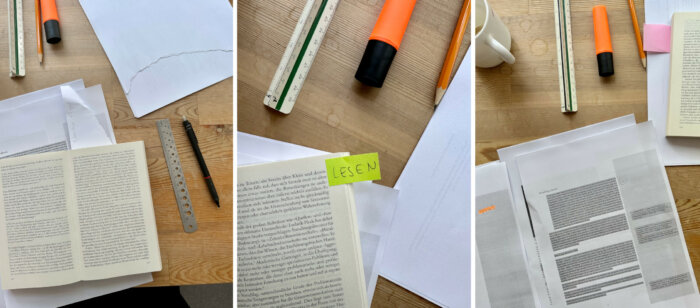
We have taken some space here to engage with the intimate entanglements of reading and writing to argue that some of the status granted to writing in academia, should be shared with reading. The three—needless to say non-exhaustive—reading modes we have discussed in this text have different values in academia, dependent on their relation to writing. They also bring different joys, and they are more or less collective. By attending to these modes and the micro-practices of spaces, times, bodies and materialities through which they unfold, we have tried to make a varied and heterogeneous activity in academia more visible, and pointed to unfulfilled potentials. Reading is fundamental to academic work—it could be a key point to engage in the development of academic practices in general. Anthropology has had a writing culture debate—it may now be the time for attending to academia as reading culture. We have offered some parameters and a vocabulary to start the exchange.
In conclusion we invite you, dear reader, to reflect with us on the balance of reading about, reading around and reading aloud in your everyday working environment, and how to practically nourish milieus conducive to the transformative, radical basic power of reading here in academia. Consider first if students don’t read the literature we put compiled onto the syllabus… isn’t it a great worry? As teachers we feel entitled to be disappointed or morally appalled when our students have not read the way we wanted them to. Consider further, what if our colleagues are not reading, are reading ineffectively, or are not enjoying the work time they spend reading? Skimming, speed reading, and computerized distant reading are all legitimate practices within the overall craft of reading when appropriate, of course. However, are we failing as academics, or even complacent in some kind of social and epistemic injustice if other academics around us don’t get the benefits and pleasures of the craft of reading, and possibility to do their work well?
Paraphrasing Joe Orlando and Al Hartley panel reproduced in Fig. 8 “please go away… we’re reading” may be the phrase which saves academia.

_Acknowledgements
The author collective extends its gratitude to Laura Kocksch and Koushik Ravi Kumar for reading, doing, and being with us.
_How to Cite
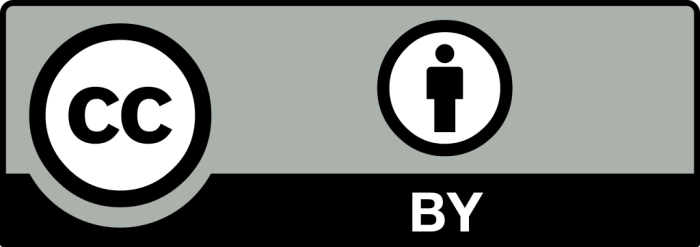
_Endnotes
- [1] Vladimir Nabokov, Good Readers and Good Writers (1948).
- [2] Bruno Latour and Steve Woolgar, Laboratory Life: The Construction of Scientific Facts (Princeton: Princeton University Press, 1986).
- [3] Steffen Martus and Carlos Spoerhase, Geistesarbeit: Eine Praxeologie der Geisteswissenschaften (Berlin: Suhrkamp, 2022).
- [4] Friedrich Nietzsche, Nachgelassene Fragmente 1875–1879 (Berlin/New York: De Gruyter, 1988). Doi: 10.1515/9783110860986.
- [5] Tobias Brücker, Auf dem Weg zur Philosophie: Friedrich Nietzsche schreibt ‘Der Wanderer und sein Schatten’ (Paderborn: Brill | Fink, 2019). Doi: 10.30965/9783846764053.
- [6] Michael Hagner, Zur Sache des Buches (Göttingen: Wallstein, 2015), 220.
- [7] Klaus Benesch, Mythos Lesen: Buchkultur und Geisteswissenschaften im Informationszeitalter, Wie wir lesen—zur Geschichte, Praxis und Zukunft einer Kulturtechnik, Vol. 2 (Bielefeld: transcript, 2021). Doi: 10.14361/9783839456552.
- [8] Paul N. Edwards, How to Read a Book, v. 5.0 (University of Michigan School of Information, n.d.), <https://pne.people.si.umich.edu/PDF/howtoread.pdf>.
- [9] Edwards, “How to Read a Book, v. 5.0.”
- [10] Max Liboiron, “Exchanging,” in Transmissions: Critical Tactics for Making and Communicating Research, ed. Kat Jungnickel (Cambridge, MA: MIT Press, 2020), 89–107.
- [11] Niklas Luhmann, “Lesen lernen,” in Niklas Luhmann: Schriften zu Kunst und Literatur, ed. Niels Werber (Frankfurt, Main: Suhrkamp, 2008), 9–13.
- [12] Eric Livingston, An Anthropology of Reading (Bloomington: Indiana University Press, 1995).
- [13] Pun intended.
- [14] Anne Dippel, “Trivial Pursuits?,” Journal for European Ethnology and Cultural Analysis (JEECA) 6, no. 1 (2022): 5–24, <https://elibrary.utb.de/doi/abs/10.31244/jeeca.2021.01.01>.
- [15] Mace Ojala and Katrine Meldgaard Kjær, “Reading Code Aloud,” Digital Humanities Quarterly, forthcoming.
- [16] Estrid Sørensen, The Materiality of Learning: Technology and Knowledge in Educational Practice, Learning in Doing (Cambridge, New York: Cambridge University Press, 2009).
- [17] Rainald Goetz, “Absoluter Idealismus: Bericht,” Zeitschrift für Ideengeschichte 17, no. 1 (2023): 5–16. Doi: 10.17104/1863-8937-2023-1-5.
- [18] Goetz, “Absoluter Idealismus: Bericht,” 5–16.
- [19] Joe Orlando and Al Hartley, “The Girl Who Saved the World,” Strange Tales 1, no. 49 (1956).


